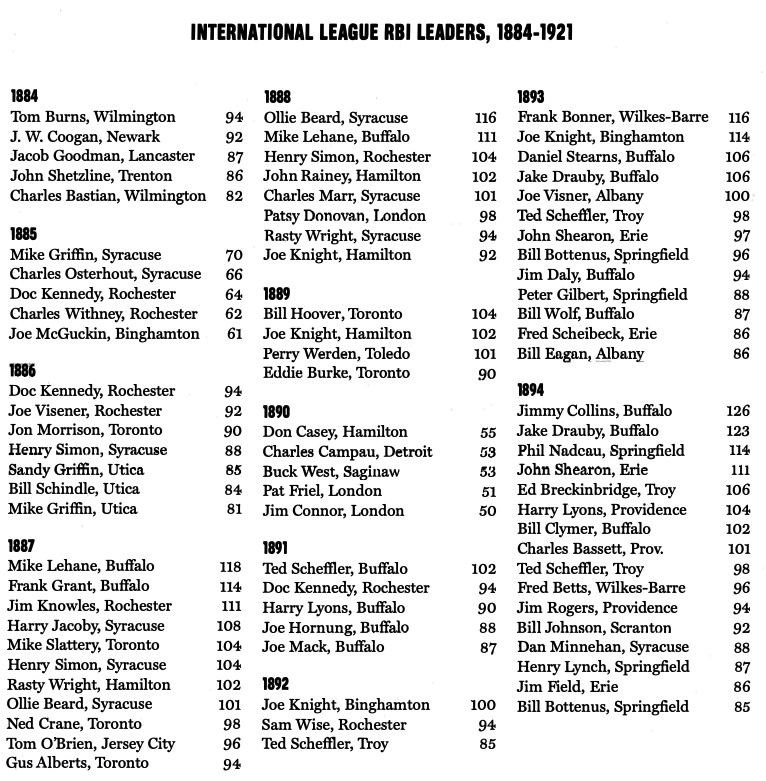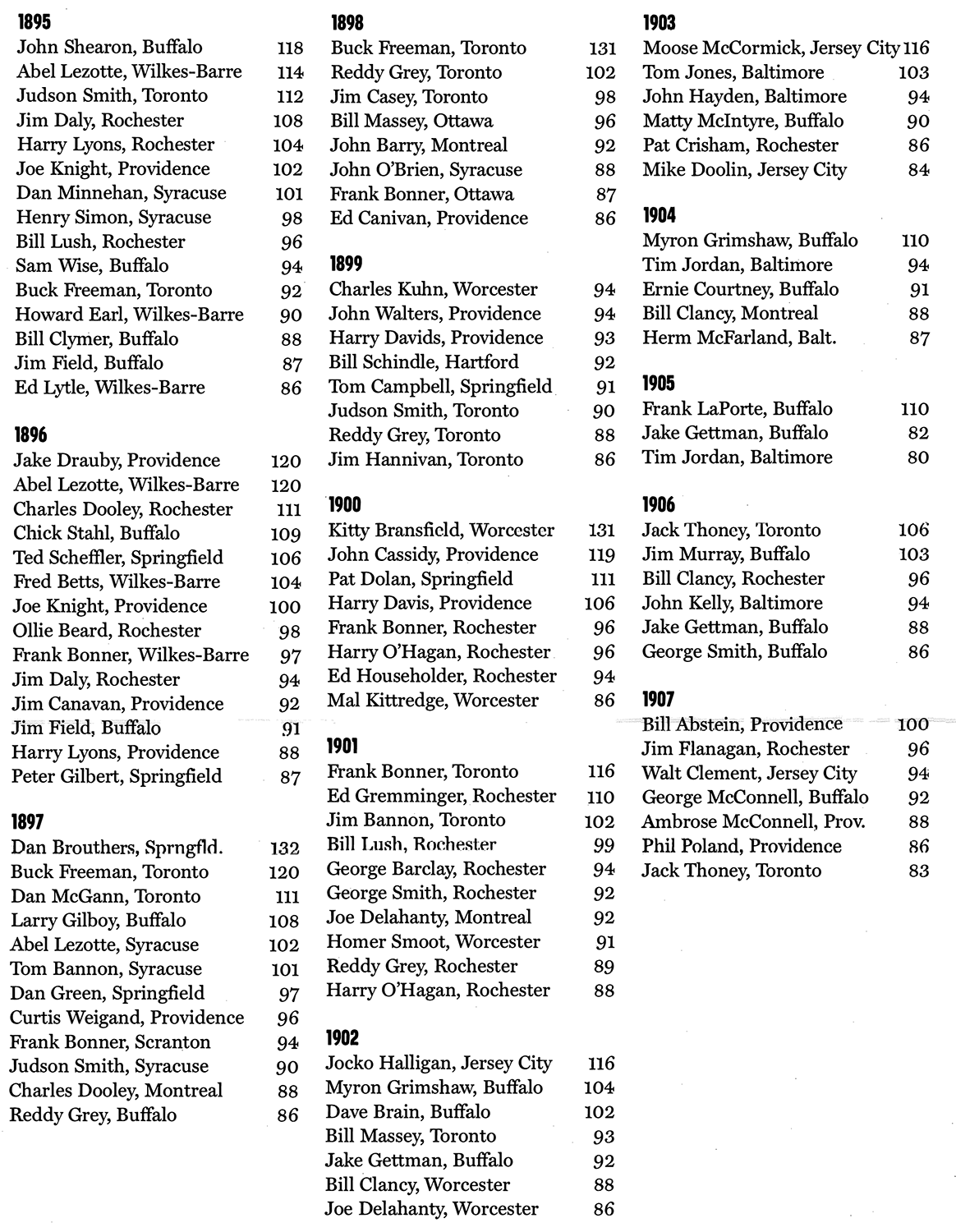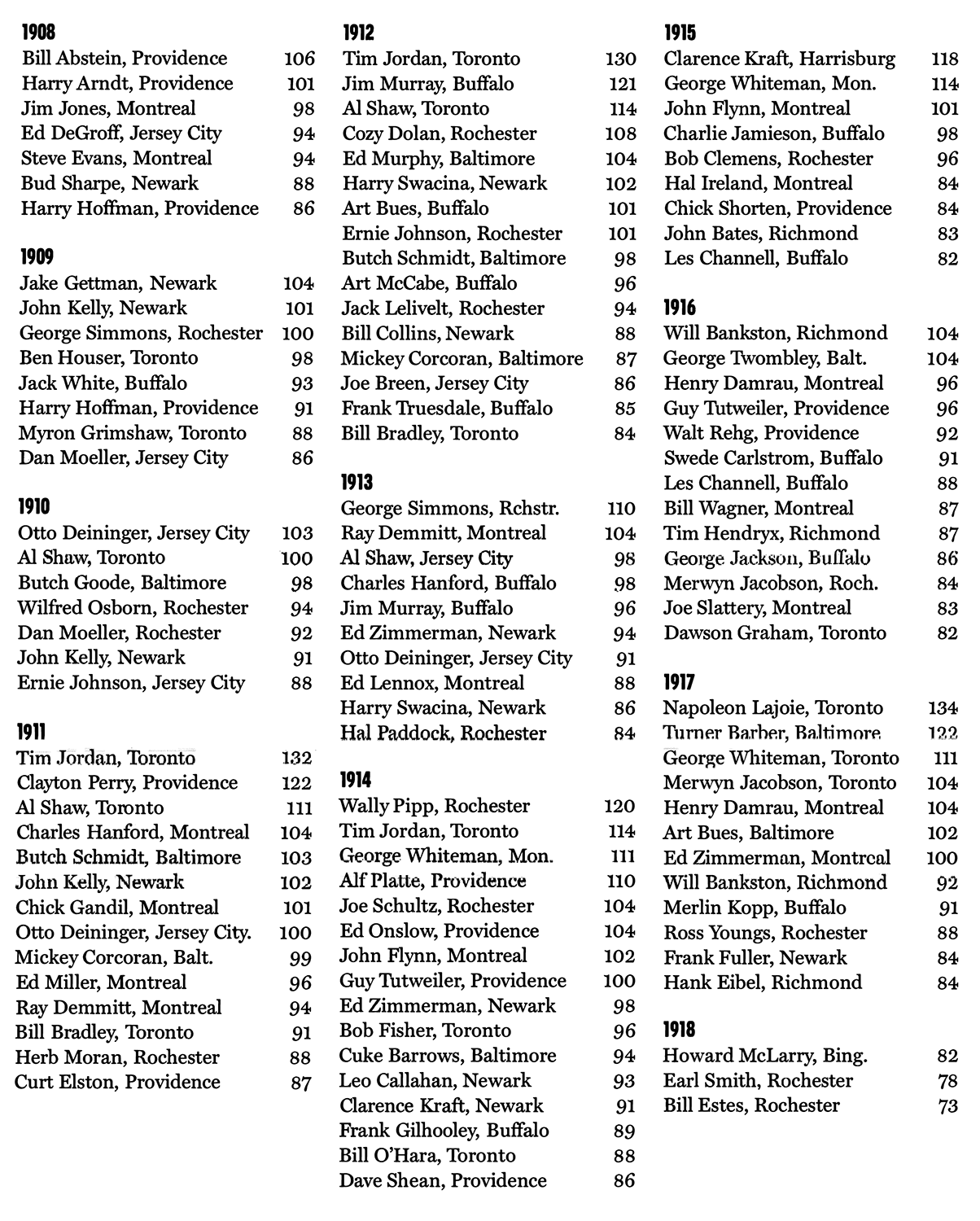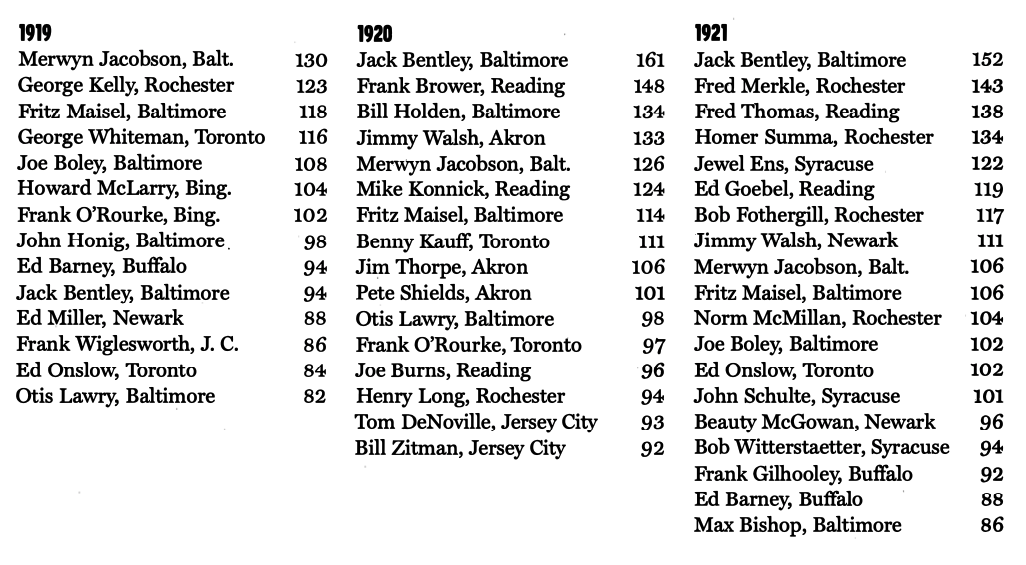Early RBI Leaders in the International League
This article was written by David Chrisman
This article was published in 2002 Baseball Research Journal
It is obvious that the game of baseball has changed drastically over the years. With the value of RBI compilations accepted now as a matter of course the serious historian must take note of their prominence in league history-and by extension, baseball itself. As far as the International League is concerned, the 1920s mark the heyday of RBI totals-individually and team-wise.
The 1930s was another strong decade for scoring and RBI, but by the 1940s and 1950s, 100-RBI accumulations began to dwindle. After 1960 Runs Batted In totals in excess of 100 have been rare.
Runs Batted In as a baseball statistic is a relatively recent phenomenon. Reported as early as 1880 by the Chicago Tribune, it was not kept as an official statistic by the major leagues until 1920, and the International League the year after. Most newspaper box scores did not note the statistic until 1930.
This study explores the early RBI totals in the International League from 1884 through 1921. Using old newspapers and sports publications, I tabulated RBI accounts in the circuit between 1884 to 1921. Such a task is not as cut and dried as it seems. Marshall Wright, in his brilliant The International League Year-by-Year Statistics, 1884-1953, notes that even the date the International League began (as well as its continuity) is open to question. The earlier league (the Interstate Association) disbanded in 1883 and reopened its doors in 1884 using the name Eastern League. Most observers accept that campaign as the beginning of the circuit now known as the International League. However, there is a dilemma concerning the 1885 season and how it affects the league’s continuity. As Wright points out, there were two antecedents of the International League in 1885; the New York State League and the Eastern League.
In a shortened season, the Syracuse Stars won the New York State title, and Mike Scanlon’s Washington Nationals were the Eastern League Champions. The question is: which of the two is the legitimate forerunner of the International League?
In 1935 the International League itself (under Frank Shaughnessy’s guidance) accepted Syracuse’s win in the New York State League as the rightful second year in the circuit’s history. However, some historians question this, and are more apt to accept the Eastern League as a valid predecessor. Regardless, the confusion leaves the door ajar for debate. I will accept Shaughnessy’s view of the dilemma for the sake of clarity. Wright’s treatise also insists that there is a similar perplexity regarding the 1886 season. There is another dichotomy: Utica won the New York State League pennant (the third year of the International League) and Newark’s Little Giants ran away and hid in the Eastern League. Again, for the sake of clarity, I will accept Utica as the third-year champs.
Let us assume that the International League began play in 1884. J.W. Coogan of Newark won the batting title with a mark of .380, while Wilmington’s Tom “Oyster” Burns led the league in home runs (11) and RBI (94). Coogan was a close second with 92. In the abbreviated 1885 campaign, Syracuse’s Mike Griffin won the RBI crown with a mere 70, In 1886, Rochester’s Doc Kennedy drove in the most runs again, with 94. Buffalo’s Mike Lehane edged his teammate Frank Grant, the Bisons’ early black star, for the 1887 RBI title—the first time we had yearly totals in excess of 100.
Jake Drauby, a teammate of Jimmy Collins in Buffalo in 1894, was a long-time International League slugger in the 1890s. Toronto’s Buck Freeman had a two-year reign as a slugger before returning to the National League in 1898. In 1901 he jumped from the Boston National League team to the new Boston Americans. In 1903 he became the first player to lead both leagues in home runs when he hit 13 for the Americans. In addition, he led the AL in RBI totals in 1902 and 1903.
Another early International League slugger of note was Abel Lezotte of Wilkes-Barre and Syracuse. Three times his RBI count exceeded 100. Worcester’s Kitty Bransfield had a dream season in 1900, giving every promise of major league stardom.
However, it was not to be. In 1901 he joined the Pittsburgh Pirates, one of the greatest teams of that period. Bransfield became a “good field, no hit” worker among his more illustrious teammates. However, his rookie year provided his best offensive numbers of his career, as he hit .295 with 91 RBI and 92 runs scored. After hitting .223 in 1904, he was swapped with two other to the Phillies for first baseman Del Howard. The Pirates would continue to have problems at first base for the next 15 years, blaming it on the “Bransfield Curse.”
The yearly totals of RBI in the early years in the circuit are shown on the following lists.
From 1884 through 1959, Baltimore (72) and Buffalo (70) have had the greatest number of players who have reached or surpassed 100 RBI in one season. Rochester has 48 (and still counting), Toronto bowed out with 45, and Montreal had 38. Providence was a leader in the early years. Since 1960 Rochester has had a mere six players who have reached the 100 RBI total in one season. Richmond and Columbus have had five and Tidewater (Norfolk) four. In 1970 Rochester’s Roger Freed had 130 RBI—the top total since 1960. Recently, in the merger of the leftover American Association teams with the International League, RBI totals have made a comeback. Prior to 1960 only six players had won the International League RBI title with less than 100 RBI, and on two of these occasions (1890 and 1918), the season had been shortened. In 1943 Baltimore’s George Staller could muster only 98 in that war-torn year, struggling with one of the deadest balls known to man. Subsequent to 1960 the RBI leader has had less than 100 on twenty occasions.
Who knows what the future holds for minor league baseball? Over the winter months of 1997-1998, the American Association passed out of existence. Its member cities were dispersed between the International League and the Pacific Coast League. Those of us who love minor league baseball mourn the death of the Association. Both the Pacific Coast League and the International League are cumbersome reminders of how oblivious the powers-that-be seem in regard to tradition—which has been the bedrock of baseball’s popularity for most of the preceding century. This account has introduced the fan to early RBI tabulations in a vibrant minor league. It is also an attempt to remind the public that one of baseball’s real strengths is its ability to harken back to a bygone era.
DAVID F. CHRISMAN is a retired English educator who taught at the secondary and college level. He is currently a freelance writer with a particular interest in the minor leagues prior to 1960.
Sources
Reach, A.J. Company. Reach Official Baseball Guide, Philadelphia, PA: 1884-1935.
Spalding Athletic Library, American Sports Publishing Company. New York, NY: 1885-1938.
Spink, Charles C. and Sons, Sporting News Baseball Guide, St. Louis, MO: 1942-2001.
Wright, Marshall D. The International League, Year-by-Year Statistics, 1884-1953, Jefferson, NC: McFarland, 1998.
Notes
1. Marshall D. Wright, The International League, Year-by-Year Statistics, 1884-1953, p. 3.
2. Wright, 10.
3. Wright, 13.
4. Wright, 14.






